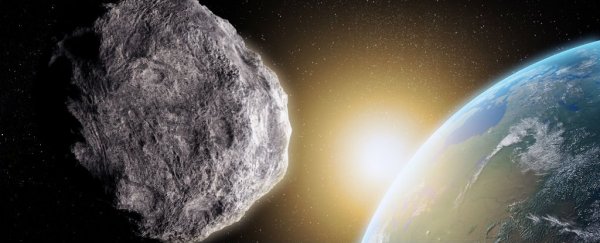NASA is certainly not in the business of spreading panic over asteroid strikes - every time one comes close, we see yet another press release telling us that all known 'potentially hazardous asteroids' have less than a 0.01 percent chance of impacting Earth in the next 100 years.
But with NASA detecting around five new asteroids every night, there are a whole lot out there still to be discovered, and if one happens to catch us by surprise, the only option we'll have is to prepare for the worst.
"The biggest problem, basically, is there's not a hell of a lot we can do about it at the moment," Joseph Nuth from NASA's Goddard Space Flight Centre said at the annual meeting of the American Geophysical Union in San Francisco this week.
What's perhaps most unsettling is we're not talking about those unexpected asteroids that we detect days or weeks out from their closest approach to Earth - it takes years to complete some kind of 'deflection' operation, so anything less than that, and all we have left to consider is mass evacuation.
To be clear, for the most part, Earth has been left alone by massive asteroids and comets.
But as Alan Yuhas reports for The Guardian, there have been two notable "close encounters" in recent years: one in 1996, when a comet collided with Jupiter; and one in 2014, which made a flyby just past Mars, our closest neighbour.
Scientists had detected that 2014 comet 22 months before it zoomed past Mars. But Nuth says even that amount of time would have been nowhere near enough to do anything about it if Earth - not Mars - was in its path.
"If you look at the schedule for high-reliability spacecraft and launching them, it takes five years to launch a spacecraft," he said. "We had 22 months of total warning."
While NASA has established an Office of Planetary Protection - manned by just one scientist as recently as two years ago - Nuth says that we've largely been ignoring the threat of comets in order to keep tabs on asteroids instead.
According to the Planetary Society, we have discovered roughly 60 percent of the near-Earth asteroid and short-period comets (with orbital periods of less than 200 years) that are estimated to be 1.5 kilometres or larger.
So what's the solution? Nuth and his team, who were also present at the meeting, recommend that NASA builds an intercepting spacecraft now, and keeps it in storage - just in case we need it.
They also advise that NASA builds a "simple observer spacecraft" that can be launched towards the asteroid or comet threat to give the interceptor a better idea of its orbit, movements, shape, and spin axis.
"In other words, it tells us where we're going to be most effective in hitting it, in order to have the maximum effect and the maximum probability of deflecting that comet from impacting Earth," he said.
Nuth says if we detect an incoming asteroid or comet, and we already have a functional interceptor in storage, we could launch it within a year, which could be enough to deflect it.
"This could mitigate the possibility of a sneaky asteroid coming in from a place that's hard to observe, like from the Sun," he said.
But we'd have little hope if we started building the spacecraft after we'd detected a threat.
Cathy Plesko, a scientist at Los Alamos National Laboratory who is not in Guth's team, told The Guardian that there are two ways these deflection operations could go: either we equip a spacecraft with a nuclear warhead, or we build a "kinetic impactor" - basically, a giant cannonball.
"Cannonball technology is actually very good technology, intercepting an object at high speed actually ends up being more effective than high explosives," she said.
There's also a bit of an elephant in the room, because with so many large objects whizzing around in space, it's almost inevitable that we're going to be hit at some point, whether it's soon, or many centuries into the future.
Guth pointed out that massive asteroids and comets - like the one that ended the reign of the non-avian dinosaurs - are extremely rare, but they're a definite possibility that we need to be better prepared for.
"[T]hey are the extinction level-type events. When you're talking about things like dinosaur killers, they're 50 to 60 million years apart, potentially," he said.
"You could say, of course, we're due," he quipped, "but it's a random guess at that point."
You can watch the whole seminar below:
